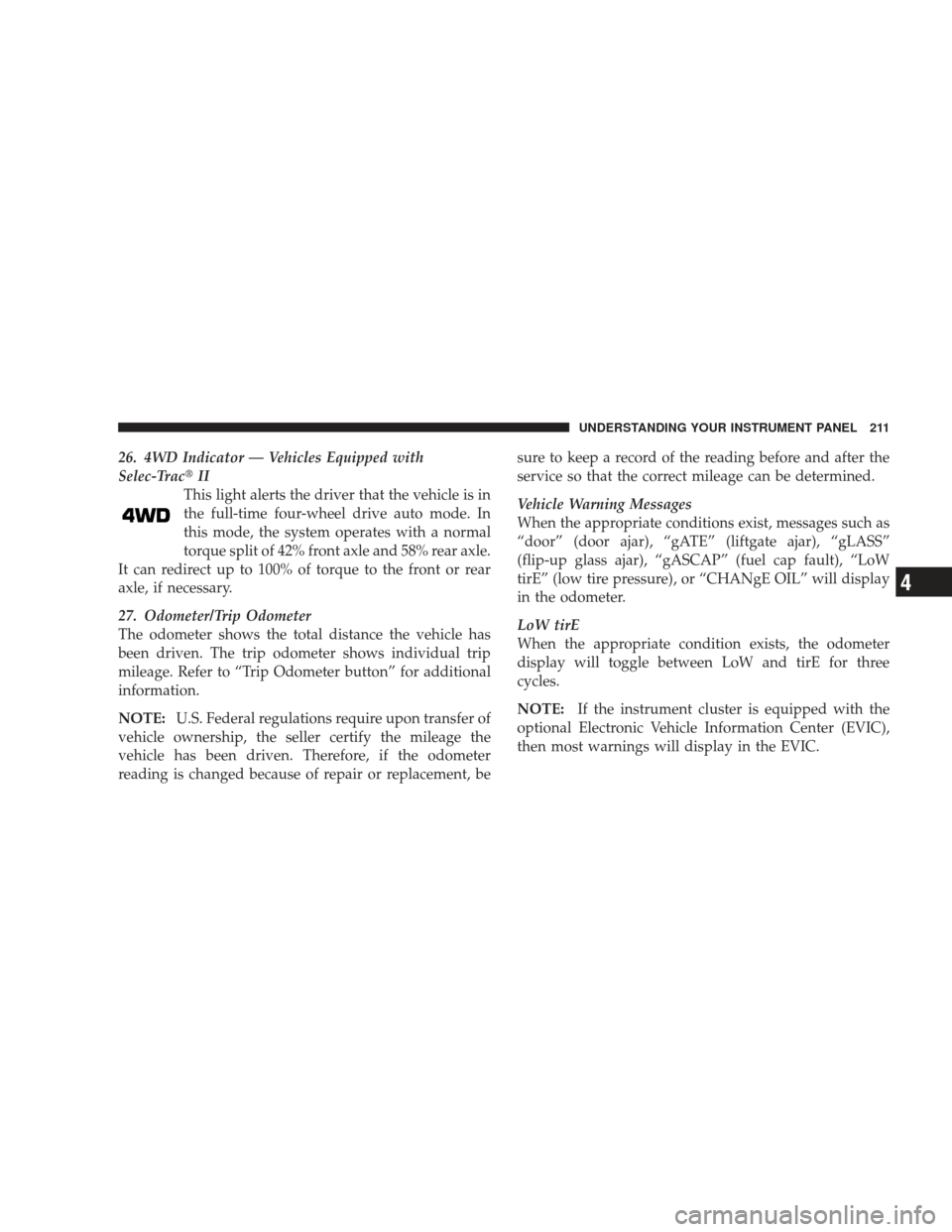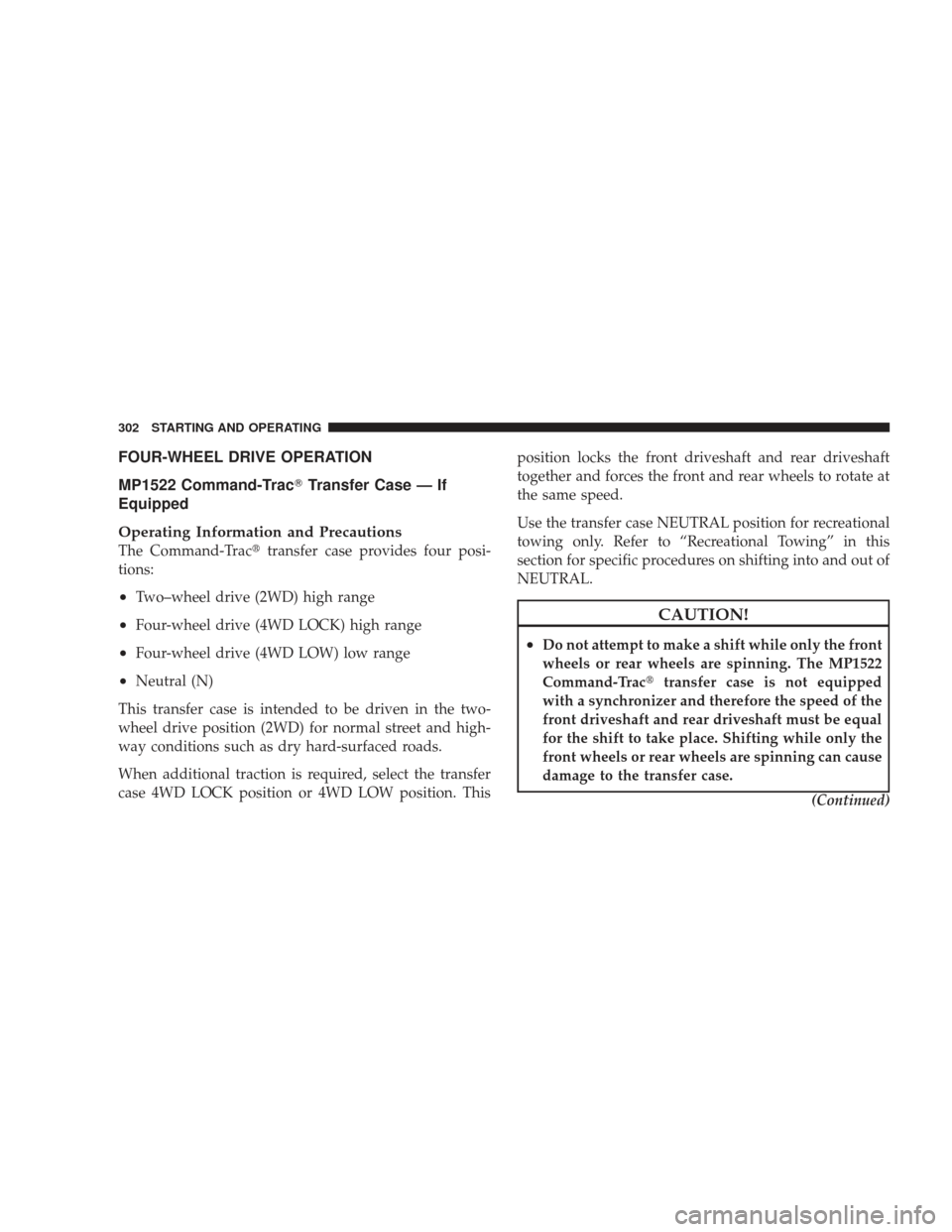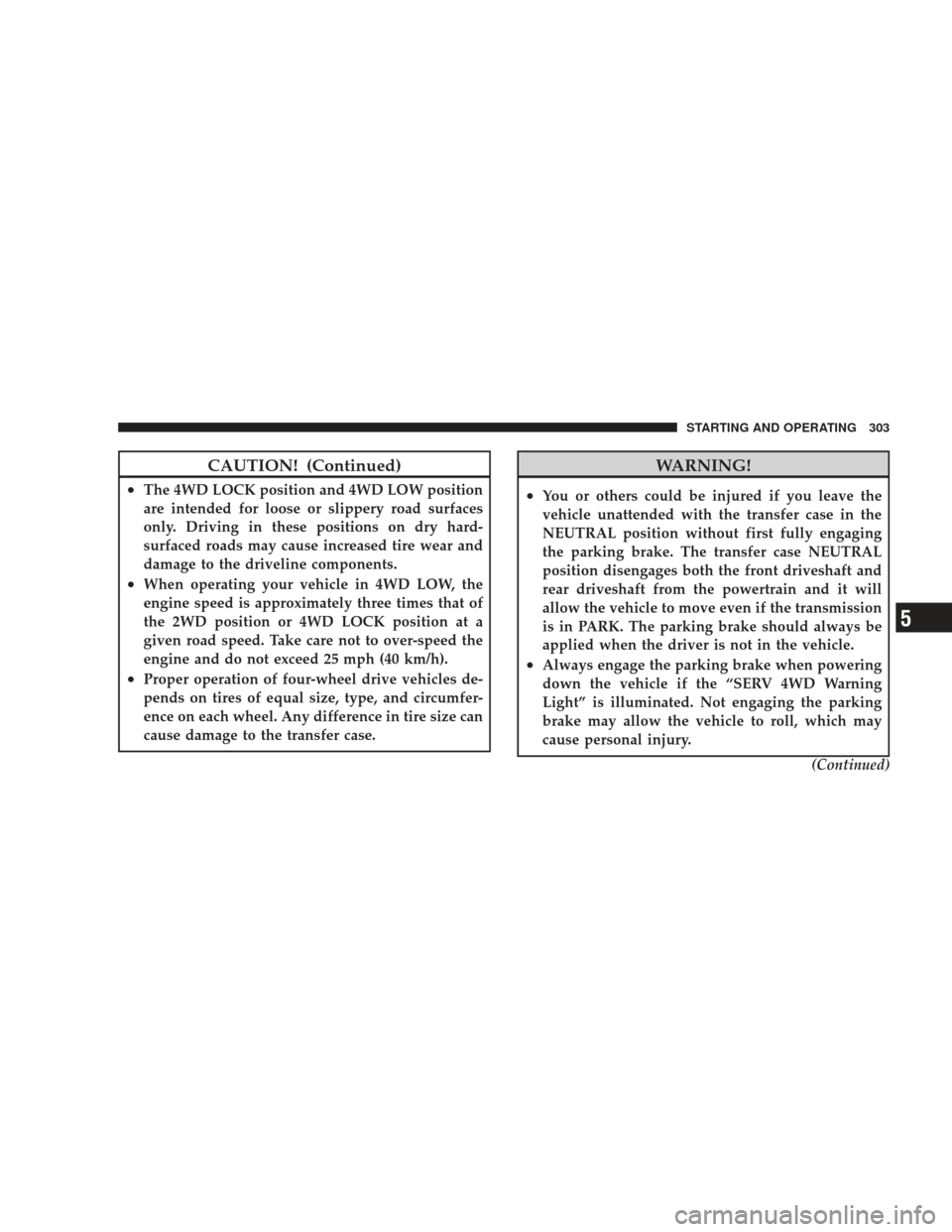Page 65 of 506

lodged under the seat and interferes with operation of
the weight sensors, a fault will occur which turns on both
the “PAD Indicator Light” and the “Airbag Warning
Light.” Once the lodged object is removed, the fault will
be automatically cleared after a short period of time.
•TheDriver and Passenger Airbag/Inflator Units are
located in the center of the steering wheel and the
passenger side of the instrument panel. When the ORC
detects a collision requiring the airbags, it signals the
inflator units. A large quantity of non-toxic gas is
generated to inflate the front airbags. Different airbag
inflation rates are possible, based on collision severity
and occupant size. The steering wheel hub trim cover
and the upper passenger side of the instrument panel
separate and fold out of the way, as the bags inflate to
their full size. The bags fully inflate in about 50 to 70
milliseconds. This is about half of the time that it takes
to blink your eyes. The bags then quickly deflate while
helping to restrain the driver and front passenger. The driver’s front airbag gas is vented through the vent
holes in the sides of the airbag. The passenger’s front
airbag gas is vented through the vent holes in the sides
of the airbag. In this way, the airbags do not interfere
with your control of the vehicle.•The
Occupant Classification Module (OCM) is lo-
cated beneath the front passenger seat. The OCM
classifies the occupant into categories based on the
measurements made by the seat weight sensors. The
OCM communicates with the Occupant Restraint Con-
troller (ORC). The ORC uses the occupant category to
determine whether the front passenger airbag should
be turned off. It also determines the rate of airbag
inflation during a collision.
•Your vehicle has four Weight Sensorslocated between
the seat and the floor pan. The weight sensors measure
applied weight and transfers that information to the
OCM.
THINGS TO KNOW BEFORE STARTING YOUR VEHICLE 63
2
Page 209 of 506

15. Tachometer
This gauge measures engine revolutions-per-minute
(RPM x 1000). Before the pointer reaches the red area,
ease up on the accelerator to prevent engine damage.
16. 4WD LOW Indicator — If EquippedThis light alerts the driver that the vehicle is in
the 4WD LOW mode. In this mode, the front
driveshaft and rear driveshaft are mechanically
locked together forcing the front and rear
wheels to rotate at the same speed.
17. Hill Descent Control Indicator — If Equipped The symbol indicates the status of the Hill
Descent Control (HDC) feature. The lamp will
be on solid when HDC is armed. HDC can only
be armed when the transfer case is in the “4WD
LOW” position and the vehicle speed is less then 30 mph (48 km/h). If these conditions are not met while attempt-
ing to use the HDC feature, the HDC indicator light will
flash on/off.
18. TOW/HAUL Indicator — If Equipped
This light will illuminate when selecting
TOW/HAUL. The TOW/HAUL button is lo-
cated on the gearshift bezel.
19. 4WD Indicator — Vehicles Equipped with
Command-Trac� This light alerts the driver that the vehicle is in
the four-wheel drive mode. In this mode, the
front driveshaft and rear driveshaft are me-
chanically locked together forcing the front and
rear wheels to rotate at the same speed.
UNDERSTANDING YOUR INSTRUMENT PANEL 207
4
Page 213 of 506

26. 4WD Indicator — Vehicles Equipped with
Selec-Trac�II
This light alerts the driver that the vehicle is in
the full-time four-wheel drive auto mode. In
this mode, the system operates with a normal
torque split of 42% front axle and 58% rear axle.
It can redirect up to 100% of torque to the front or rear
axle, if necessary.
27. Odometer/Trip Odometer
The odometer shows the total distance the vehicle has
been driven. The trip odometer shows individual trip
mileage. Refer to “Trip Odometer button” for additional
information.
NOTE: U.S. Federal regulations require upon transfer of
vehicle ownership, the seller certify the mileage the
vehicle has been driven. Therefore, if the odometer
reading is changed because of repair or replacement, be sure to keep a record of the reading before and after the
service so that the correct mileage can be determined.
Vehicle Warning Messages
When the appropriate conditions exist, messages such as
“door” (door ajar), “gATE” (liftgate ajar), “gLASS”
(flip-up glass ajar), “gASCAP” (fuel cap fault), “LoW
tirE” (low tire pressure), or “CHANgE OIL” will display
in the odometer.
LoW tirE
When the appropriate condition exists, the odometer
display will toggle between LoW and tirE for three
cycles.
NOTE:
If the instrument cluster is equipped with the
optional Electronic Vehicle Information Center (EVIC),
then most warnings will display in the EVIC.
UNDERSTANDING YOUR INSTRUMENT PANEL 211
4
Page 289 of 506
STARTING AND OPERATING
CONTENTS
�Starting Procedures .................... 291
▫ Normal Starting ..................... 291
▫ Extreme Cold Weather (Below –20°F Or
–29°C) ............................ 291
▫ If Engine Fails To Start ................ 292
▫ After Starting ....................... 293
� Engine Block Heater — If Equipped ........ 293
� Automatic Transmission ................. 294
▫ Brake/Transmission Shift
Interlock System ..................... 295 ▫
Brake/Transmission Interlock Manual
Override .......................... 295
▫ 4–Speed Automatic Transmission ......... 296
� Four-Wheel Drive Operation ............. 302
▫ MP1522 Command-Trac� Transfer Case — If
Equipped .......................... 302
▫ MP3022 Selec-Trac II� Transfer Case — If
Equipped .......................... 308
� On-Road Driving Tips .................. 313
5
Page 292 of 506
�Adding Fuel ......................... 370
▫ Fuel Filler Cap (Gas Cap) .............. 370
▫ Loose Fuel Filler Cap Message ........... 371
� Vehicle Loading ...................... 371
▫ Certification Label ................... 371
� Trailer Towing ........................ 374
▫ Common Towing Definitions ............ 374
▫ Trailer Hitch Classification .............. 379
▫ Trailer Towing Weights (Maximum Trailer
Weight Ratings) ..................... 380 ▫
Trailer And Tongue Weight ............. 382
▫ Towing Requirements ................. 383
▫ Towing Tips ........................ 388
� Recreational Towing
(Behind Motorhome, Etc.) ................ 389
▫ Towing – Two-Wheel Drive Models ....... 389
▫ Towing — Four-Wheel Drive Models ...... 389
290 STARTING AND OPERATING
Page 304 of 506

FOUR-WHEEL DRIVE OPERATION
MP1522 Command-Trac�Transfer Case — If
Equipped
Operating Information and Precautions
The Command-Trac� transfer case provides four posi-
tions:
•Two–wheel drive (2WD) high range
•Four-wheel drive (4WD LOCK) high range
•Four-wheel drive (4WD LOW) low range
•Neutral (N)
This transfer case is intended to be driven in the two-
wheel drive position (2WD) for normal street and high-
way conditions such as dry hard-surfaced roads.
When additional traction is required, select the transfer
case 4WD LOCK position or 4WD LOW position. This position locks the front driveshaft and rear driveshaft
together and forces the front and rear wheels to rotate at
the same speed.
Use the transfer case NEUTRAL position for recreational
towing only. Refer to “Recreational Towing” in this
section for specific procedures on shifting into and out of
NEUTRAL.
CAUTION!
•Do not attempt to make a shift while only the front
wheels or rear wheels are spinning. The MP1522
Command-Trac�
transfer case is not equipped
with a synchronizer and therefore the speed of the
front driveshaft and rear driveshaft must be equal
for the shift to take place. Shifting while only the
front wheels or rear wheels are spinning can cause
damage to the transfer case.
(Continued)
302 STARTING AND OPERATING
Page 305 of 506

CAUTION! (Continued)
•The 4WD LOCK position and 4WD LOW position
are intended for loose or slippery road surfaces
only. Driving in these positions on dry hard-
surfaced roads may cause increased tire wear and
damage to the driveline components.
•When operating your vehicle in 4WD LOW, the
engine speed is approximately three times that of
the 2WD position or 4WD LOCK position at a
given road speed. Take care not to over-speed the
engine and do not exceed 25 mph (40 km/h).
•Proper operation of four-wheel drive vehicles de-
pends on tires of equal size, type, and circumfer-
ence on each wheel. Any difference in tire size can
cause damage to the transfer case.
WARNING!
•You or others could be injured if you leave the
vehicle unattended with the transfer case in the
NEUTRAL position without first fully engaging
the parking brake. The transfer case NEUTRAL
position disengages both the front driveshaft and
rear driveshaft from the powertrain and it will
allow the vehicle to move even if the transmission
is in PARK. The parking brake should always be
applied when the driver is not in the vehicle.
•Always engage the parking brake when powering
down the vehicle if the “SERV 4WD Warning
Light” is illuminated. Not engaging the parking
brake may allow the vehicle to roll, which may
cause personal injury.(Continued)
STARTING AND OPERATING 303
5
Page 306 of 506
WARNING! (Continued)
•Since four-wheel drive provides improved trac-
tion, there is a tendency to exceed safe turning and
stopping speeds. Do not go faster than road con-
ditions permit. You or others could be injured.
Shift Positions
The electronic transfer case switch is located on the center
console next to the shift lever.2WD
Rear Wheel Drive High Range - This range is used for
normal street and highway driving on dry hard-surfaced
roads.
4WD Control Switch
304 STARTING AND OPERATING